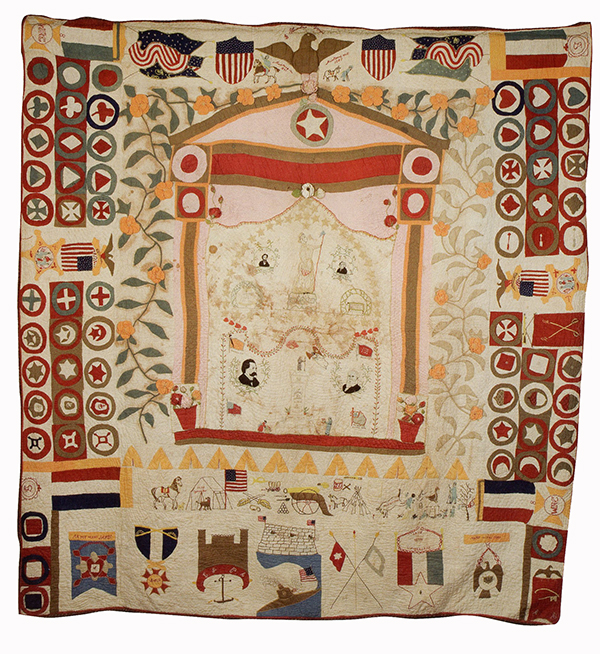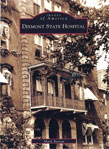Civil War Narrative Quilt

Quilt, cotton with embroidery and applique, attributed to Sarah Bright Anderson Lea, c. 1890. Collection: Sewickley Valley Historical Society
This quilt was probably made in the Fineview section of Allegheny City, sometime between 1889 and 1892. Sarah Bright Anderson Lea was the wife of Benjamin Franklin Lea, some ten years her junior, who served in the Union Army between 1863 and 1865, as a guard and later as a cook at Camp Reynolds in Pittsburgh. Mr. Lea, a substitute for an unknown draftee, was a private when he mustered out in 1865. He joined G. A. R. Post No. 162 in Allegheny City on January 19, 1889, and in the period 1890-1893 was active in the organization, serving as Post Surgeon in 1891 and being nominated for positions of Junior Vice Commander and Officer of the Day in 1893 and 1894, respectively. The quilt's design and symbols indicate that it was made in connection with a celebration or commemoration sponsored by the G. A. R. Sara Lea died January 27, 1918, and her husband died four weeks later.
Sarah Lea Nearing, Sara and Benjamin Lea's granddaughter, inherited the quilt. In 1975, Mrs. Nearing and her family, planning to move to Florida, decided that they wished the quilt to remain in the North and offered it to the Sewickley Bicentennial Committee be used as a feature of the local celebration in 1976; the acquisitions of the Bicentennial Committee subsequently formed the foundation of the Sewickley Valley Historical Society's collection. The quilt was exhibited during Sewickley's Sesquicentennial in 1990, at a 2002 folk art exhibition at the Heinz History Center and at an exhibition at the Westmoreland Museum of American Art in 2007 entitled "Made in Pennsylvania: A Folk Art Tradition."
The following, excerpted from an article by B. G. Y. Shields, appeared in the Sewickley Herald, March 24, 1976.
Quilt, means to communicate Civil War experiences
Since the beginning of time, people have been leaving traces behind. Some people erect castles to attest to their greatness; others create canvases which tell the world of their mastery with brushes and paint. More modest, of course, is folk art, but no less loving care goes into the tracings. It is man’s desire to communicate experiences with generations to follow.
Such must have been the case when Sarah Bright Anderson Lea sat beside the bed of her convalescing husband just home from the Civil War. As Ben recounted his experiences by means of sketches, Sarah proceeded to stitch, so his story would be told in the only art medium she knew, quilts.
First, “we will put the glorious symbol of peace,” we can almost hear her saying. “Do you think you can make Lincoln and Davis and Grant and Lee?” he would ask.
Whiling away the tedious hours until he was back on his feet, he would sketch and she would sew.
What developed is a remarkable story of the activities of camp life … tents, the headquarters, horses, cannons, the campfire, soldiers bagging a goose for dinner, even the picture of uniforms hung on a tree while the soldier was away for a dip in the stream.
Benjamin Franklin Lea must have agreed that “war is hell” because one scene shows the soldier going off to war proudly on his beautiful steed only to return on a donkey. For a touch of whimsy and authenticity, embroidered on the donkey is that universal scourge of war, the louse.
As a border, the Leas decided to incorporate tall the regimental patches of the G. A. R., but there is much, much more, even the Monitor and the Merrimack. About the only thing one can’t find in this historical review in stitchery is a replica of the Stars and Bars.
The reverse side of the quilt does honor to the Stars and Stripes, the grand symbol which Benjamin Franklin Lea revered. There are 44 stars, two obviously added later. Stitched finely into one of the white stripes is this message, “Collections from July 1752 to August 1890.” The later date is a clue that the last stars stand for Wyoming and Idaho, which were taken into the Union in July 1890.
Fortunately for posterity, this family heirloom fell into the right hands. While its owner, Mrs. Sara Lea Nearing, admits the now-faded banner has never been a touch-me-not, still it was always appreciated and regarded as a family treasure. One can imagine it held a fascination for her son Harvey who used to put it down on the floor on rainy days and ponder the battle scenes and the meaning of the symbolism. The quilt served as a course in American history although young Harvey didn’t realize it at the time.
As her grandmother pieced the story together, so has Mrs. Sara Nearing pieced together some of the family history that caused her grandfather to serve in the Union forces.

